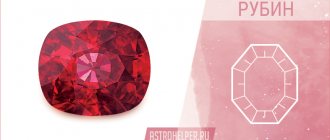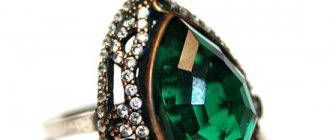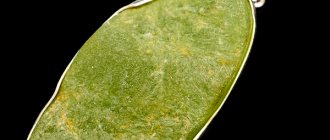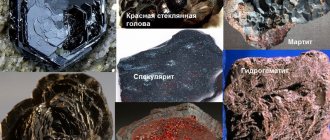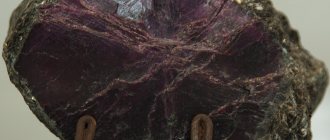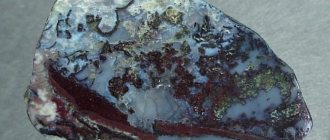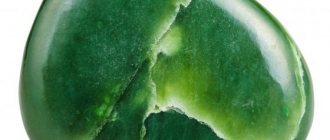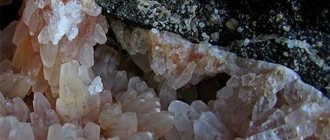- What kind of stone: Precious;
- Deposits: India, Burma, Africa, Canada, USA, Norway, Thailand, Turkey, Greece, Kazakhstan, Russia (Primorye, Urals, Krasnoyarsk Territory);
- Colors: Ruby (Red), Sapphire (Blue);
- Mohs hardness: 9;
- Transparency: Transparent and translucent;
- Density: 3.9-4.1 g/cm³;
- Formula: Al2O3;
- Suitable for zodiac sign: Everyone except Capricorns;
- How much does it cost: from $50 per carat (filled with glass), from $100 (heated without filler), from $500 (without visible defects).
Corundum is a precious stone. Sapphires and rubies are famous varieties of corundum. These are not just valuable stones, but precious stones of the first category.
It is durable, beautiful, quite expensive and very popular.
Let's consider its properties, description, varieties, deposits and areas of application.
Appearance, meaning of the stone
Corundums are a group of minerals. They are united by physical properties, chemical composition, and structure. For a long time it was generally accepted that different types of corundum are independent minerals.
But then geology and chemistry developed significantly. And it became obvious that all the minerals of the group, differing in appearance, are only different types of the same corundum.
Why does the stone have such a name? It is believed that the name comes from the Sanskrit words “kuruvinda”, “kauruntaka”, which in translation mean ruby. Around the world, corundum is called differently: padparadscha, violet, oriental diamond, leucosapphire, almandine sapphire.
It turns out there is also pure corundum. It is this kind of stone that is especially highly valued on the world market, since pure corundum is rarely found in nature.
Pure corundum
Pure stone is completely transparent, has no color, and has a bright glass luster. In appearance it resembles a diamond.
In deposits, already colored corundum crystals are most often found, in which there are all kinds of inclusions, including colloidal ones. Shades can be varied: blue, scarlet, bluish and purple, red and green.
Since ancient times, red corundums have been especially important: they symbolize power.
How to distinguish natural corundum stone from fake?
Ideal corundums are very rare, and their cost is very high. Experts have developed methods for artificially synthesizing corundum. The artificial specimen has curvilinear zoning. It may contain air bubbles. But at first glance it seems perfect.
The price of synthetic corundum is significantly lower than natural corundum. Its structure contains signs of artificial origin. They can be seen under a microscope or magnifying glass. Sometimes a polariscope and ultraviolet illumination are used.
It is extremely important to purchase corundum in specialized stores. Sellers must provide appropriate certificates for it.
To obtain artificial corundum, alumina is processed at high temperatures. There are several technologies for growing the mineral. One of them is the Verneuil method. He produces specimens that have curvilinear zoning. Natural stones do not have it. The appearance of such crystals is quite presentable.
The second technology is hydrothermal. Signs of artificial origin of such stones are very difficult to determine. To do this, it is necessary to find incorrectly grown structures.
Origin story
Corundum has a long history. Even in ancient times, a beautiful stone was in great demand and was available only to a select few. In Ancient Egypt, jewelry with corundums (sapphires) was worn by priests, and in Judea - by high priests.
Corundums began to be imported from India to Europe. That is why the stones were given such names: “oriental diamond”, “oriental amethyst”, “oriental emerald”.
Quite quickly the gem gained great popularity. He is especially appreciated in narrow diplomatic circles.
Thus, in higher diplomacy it is considered good form to present jewelry with red or blue corundum as a gift. This is a sign of respect.
Since the Middle Ages, there have been corundums in Russia. In those distant times, these stones were usually called yakhonts. The sapphire was called the azure yakhont, and the ruby was called the scarlet yakhont.
Caring for stone products?
You can preserve your favorite jewelry with a stone if you follow certain rules when caring for it:
- Keep the gemstone in a separate box with velvet sides and a soft bottom.
- Don't leave it in bright light for too long, especially in the sun.
- Do not allow the crystal to overheat. This can lead to a change in the original color of the stone to lighter shades.
- If your jewelry becomes dirty, do not use soap compositions with dyes or aggressive additives that may harm the product.
- Do not use hard or scratchy objects to clean it.
physical characteristics
Corundum is aluminum oxide. In order for corundum to form under natural conditions, it is important that there is a high alumina content, as well as a deficiency of silica.
The mineral consists of 53.2% aluminum.
Chemical formula: Al203. If corundum is pure, it has increased hardness, has a grayish tint, and is highly translucent.
It is quite rare to find completely colorless corundums that have a wonderful glassy luster.
In most cases, the mineral contains all kinds of impurities: titanium, manganese, iron and chromium. They are the ones who provide coloring of the stone in different shades.
Let's consider the principle by which natural coloring of stones can take place:
- Yellow corundums contain impurities of iron oxides.
- Pink stones are colored with iron and manganese.
- Iron causes the brown tint of the mineral.
- Titans transform corundums into sapphires.
- Chromium produces ruby.
When X-ray irradiation is carried out, more saturated shades are achieved and colorless minerals are colored. If corundums are heated significantly, they will lose color intensity: for example, purple stones will turn pink.
The hardness of corundum is 9 on the Mohs scale. This figure is higher only for diamond. Density is in the range of 3.94 – 4.10 g/cm3.
Where is corundum mined?
Corundum is a mineral that occurs in nature as a product of volcanic eruptions, in the form of segregations and veins. Beautiful specimens are regularly found in crystalline limestones, as well as in alluvial deposits that form when such rocks break down. The following countries supply minerals to the market:
- Burma is the source of the most beautiful red and pink stones.
- Thailand and Sri Lanka - as for the precious blue variety of corundum, the best specimens are mined here. Sometimes rubies are also found.
- The United States of America and India also boast deposits of sapphires.
- Australia supplies almost all varieties of corundum on the market.
- Stone deposits have also recently been discovered in Zambia.
- Opaque rubies of low quality have been found in Tanzania and Afghanistan.
- Low-quality industrial corundum is also mined in Colombia, Madagascar, Norway and China.
- Brazil is famous for its unique sapphires. In their thickness there are liquid disc-shaped inclusions.
Types of stone
The most valuable types of corundum are ruby and sapphire. These are first category gems. Let's consider all types of mineral.
Rubies
Ruby is a red gemstone. It has the first category and can cost more than a diamond. It has fairly high transparency and has various red shades. The range can range from rich, dark cherry color to pale, pinkish-red.
The most highly valued stones are those with rich shades: these are rubies of bright scarlet colors, as well as rich dark red, almost burgundy.
There are also varieties of rubies. Let's look at their main characteristics:
Star-shaped
These minerals are quite rare and have an exotic appearance. This is an optical effect when a star is visible on a cut of a stone.
Ceylonese
The stones have rich purple and lilac colors.
Siamese
Shades can be purple, reddish-brown. Minerals look very impressive and catchy.
Sapphires
The famous sapphire captivates everyone with its blue shades and high transparency. The beauty of the stone is very attractive. It is also classified as a first category gemstone.
Shades can be very diverse: from bright cornflower blue to pale, slightly bluish. The most valued stones on the market are those that have medium color saturation, but at the same time have very deep shades.
There are quite a few types of fancy sapphires: they have a wide range of colors.
Let's find out what types of fancy sapphires there are:
Purple
They attract with rich shades of purple. Previously, it was customary to call such minerals “oriental amethysts.”
Chlorosapphire
This kind of stone is very highly valued. It has a green color scheme. Sometimes it is extremely difficult to distinguish chlorosapphires from emeralds. For quite a long time, these minerals were called “oriental emeralds.”
Padparadscha
Such corundums have rich orange, pink and yellow shades, can be light or darker, and differ in the degree of transparency.
Leucosapphires
These stones have impeccable transparency. In ancient times, they were known as oriental diamonds.
Star sapphire
A fairly rare gemstone with the same asterism effect as a star ruby.
Pure stones, of absolute transparency, are highly valued. Large, well-formed crystals are also in demand among collectors.
Artificial and natural corundum
Whether corundum is a precious stone or not depends on the origin. Natural is called precious with good reason. A cheap imitation of natural is synthetic. This is not a fake, but an artificial variety, a man-made “clone” of a gemstone. Imitation glass is similar to natural stone in appearance, but its composition and characteristics give it away as a fake. Synthetic and natural corundum are completely identical in color, gloss, and physical and chemical properties. And sometimes a synthetic specimen is superior in color saturation and purity to its natural counterpart. Determine from the photo where the crystal is natural and where it is grown.
Artificial corundum differs from sapphire in that the former takes thousands of years to form, while the latter is grown in the shortest possible time and in “greenhouse conditions.” And this affects the appearance of the stones.
The same can be said about synthetic corundum (No. 1, 2, 3 in the photo above), it differs from ruby (No. 4, 5, 6) in that it is not a precious stone, although it looks perfect.
Red corundum, photo: Cran Cowan
Corundum yellowish, photo: Cran Cowan
Green corundum, photo: Cran Cowan
The first large artificial stone was created at the end of the 19th century in France. Currently, synthetic corundum is produced on an industrial scale in Germany, the USA, Switzerland, and Russia.
Corundum in jewelry from the times of the USSR
In our country, synthetic stones began to be grown in the early 50s of the last century. The first were ruby corundums, but soon artificial sapphires, alexandrites, topazes, and amethysts appeared. The Soviet jewelry industry worked primarily with them. So, when purchasing jewelry from the 70s - 90s of the 20th century today, there is no doubt that the stones in them are by no means natural. Not a single independent deposit has been registered in the USSR. To this day, the gem is only rarely found as an associated mineral in corundum deposits in the Urals, Karelia and the Kola Peninsula.
The cost of artificial crystals was exceeded in trade by 1000 times! A very profitable enterprise. The imitation was of such high quality that it is still considered the best in the world. And the demand for vintage jewelry from the Soviet Union among collectors is high.
You can distinguish artificial crystals from natural ones using a gemological spectrometer: the absorption spectra of stones are different. In the structure of a synthetic crystal, under a microscope, wavy lines are visible, left by growth, like rings on a cut of wood. And in ultraviolet rays it glows green.
Obtaining synthetic crystals
Synthetic corundum is produced in several ways: by the Czochralski method, from the gas phase, from solutions in the melt, and by the zone melting method.
As a result of the processes, artificial varieties of corundum are formed, similar to natural ones, and completely original with their own names.
Artificial crystals are colorless; the color of the birthstone is determined by the addition of chemicals. Ruby requires chromium and iron; synthetic sapphire-corundum is a crystal with the addition of titanium; for yellow - nickel oxide; for green - magnesium, zinc, cobalt; for purple - iron, chromium and titanium in a mixture. In order for artificial stones to demonstrate the optical effect of asterism, rutile is added. For the “Alexandrite effect” you need vanadium oxide.
An innovative glass substitute called “sapphire glass” is highly valued. Scope of application: watches, LEDs, smartphone and tablet screens.
Magic properties
First of all, corundum helps active, strong-willed, purposeful people. These stones are able to activate a person’s internal resources and help him achieve his goals.
You can gain confidence, emotional balance, and significantly improve your memory if you regularly wear jewelry with corundum.
It has long been known that corundums can enhance the thirst for knowledge, as well as promote the activation of mental activity.
This talisman will be useful for students and scientists, inventors, as well as representatives of creative professions, and anyone who creates or implements something new.
Experts also divide the direction of the stone’s influence depending on the type of jewelry:
- The ring helps to realize hidden abilities and develop spiritually. You can unexpectedly discover new talents in yourself if you regularly wear a ring with corundum.
- Earrings provide an objective analysis of behavior, actions, and also evoke thoughts about the meaning of life. It is important that corundum earrings often help to establish harmonious relationships with the entire world around you.
- For emotionally unstable people, it is best to choose pendants . They allow you to cope with anxiety and aggression, gain increased performance, and forget about anxiety and mood swings.
It is recommended to wear the ring only on the middle finger, on the right hand, to achieve maximum effect.
Areas of use of corundum
Depending on the physical and aesthetic conditions of corundum, the scope of application of the raw material is different.
Jewelry
In jewelry, the best examples of natural or synthetic materials are in demand. Gems are inserted into earrings, pendants, rings, brooches, and bracelets.
Ring with corundum
Men's segment - rings, cufflinks, tie clips.
The publicly available assortment of jewelry stores is synthetic corundum in 925° silver or 585° gold. Elite - real in high-carat gold or platinum.
The cost of budget accessories is thousands of rubles. Prices in the premium segment are tens of thousands.
Artificial corundums are valued at 100–700 rubles.
Before and after treatment
Other areas
Durable artificial raw materials, rejected by jewelers, are used by industry:
- abrasive material in grinding machines; sometimes it’s just a whetstone or regular sandpaper;
- products from the radio electronics and precision engineering industries (lasers, drilling rig parts, medical instruments);
- glass in rockets, airplanes, mobile gadgets - synthetic sapphire;
- parts of luxury wristwatch mechanisms;
- thermal insulation (a millimeter corundum layer is similar to 50 mm of mineral wool);
- grinding paste.
In the era of vinyl records, “eternal” styli for turntables were made from corundum.
Medicinal properties
Traditional healers place a lot of trust in corundum.
It is believed that you can wear jewelry with a stone, have the mineral with you, for example, in a bag, or only occasionally wear jewelry. And this will allow you to quickly cope with some diseases, ensure the restoration of health, and stimulate the normal functioning of various systems in the body.
It is believed that the directional effect of the stone on a person directly depends on the color of the corundum.
Let’s find out exactly what advantages corundums of different shades have:
- Rubies restore normal metabolic processes. They are useful for all people with disorders of the cardiovascular system, as they improve blood circulation. Also, red corundums activate the functioning of the endocrine glands and restore hormonal levels.
- Sapphires can help gradually return normal eye and cranial pressure. It is blue stones that are beneficial for the eyes and are used in the treatment of eye diseases.
- Yellow corundums have long been known as stones responsible for a person’s appearance. They are quite capable of preserving youth and providing a rejuvenating effect. It is important that with such minerals you can quickly restore metabolic processes and improve the functioning of the gastrointestinal tract. This has a positive effect on the condition of the skin, hair, and also on the figure.
- Violet corundums are extremely beneficial for the nervous system, they save you from depression. They are recommended to be worn by people who suffer from anxiety and mood swings. It is useful to wear purple corundum if there have been skull injuries or concussions. They also help with neuralgia and vascular diseases.
Combine different stones to provide essential support to the body.
Jewelry with Corundum
Transparent crystals (sapphire and ruby) are considered precious and suitable for making jewelry. The use of gemstones in jewelry making is popular. The stone looks very modest.
It has a gray color, so rare crystal clear specimens are especially prized. The crystal has the wonderful property of being painted in almost all shades. Some gems have natural colors:
- white;
- blue;
- red;
- yellow.
Also read: Rose quartz is a symbol of love and family happiness
Popular jewelry inserts are made from sapphires and rubies. The price depends on transparency, color, framing. Jewelry with brown corundum is cheaper than others.
The price of jewelry consists of quality, price of crystals, precious metals, inserts of other jewelry. The cost of jewelry is approximate, exact data can be obtained in the sales region.
Who is corundum suitable for? Let's find out the correspondences according to the zodiac signs
Let's find out which zodiac signs corundum is suitable for. This stone will be an ideal option for Pisces, Cancers and Aquarius . It will give strength, confidence, concentrate positive energy and repel negative energy.
It is believed that the mineral not only helps businessmen and creative people, but also protects against the evil eye.
It is believed that Aries should not wear corundum. In fact, this restriction only applies to young representatives of the sign.
For mature Aries, who have already crossed the 40-year mark, the mineral also helps a lot, both in their personal lives and in work and creative pursuits.
But the stone is not recommended for Capricorns at all. This is the only zodiac sign for which this stone is simply contraindicated: due to the mismatch of energies, you can get a completely opposite effect.
Corundum is well suited for representatives of other zodiac signs. Only it is better for them to combine it with some additional talismans.
For example, for Taurus to carry corundum with them in a small bag along with turquoise, and for Leo the optimal addition to corundum would be amber or brown agate.
Talismans, amulets
Amulets and talismans made of corundum can have great power. Thus, it is believed that ruby attracts positive energy and creates protection for its owner.
Sapphire talismans are often carried with them to attract love energy. Absolutely transparent corundum can help you achieve success, confidence, and develop willpower - it is a stone with special power.
Rings or pendants most often become amulets. A good option is to carry the raw mineral with you without showing it to anyone.
What stones does it go with?
You can combine corundums with various stones, depending on their shade. For example, sapphires harmonize perfectly with alexandrites.
Transparent corundums are suitable for almost any stone. You can also create ensembles with semi-precious stones: for example, combine rubies and garnets, green sapphires and malachite, transparent corundums and amethysts.
Place of Birth
The stone is mined in many countries around the world. The main deposits include:
- Russia (Kola Peninsula, Karelia, Ural, Chelyabinsk region), Krasnoyarsk Territory.
- USA.
- Norway.
- Canada.
- Greece.
- Madagascar.
- Thailand.
- Burma.
- Sri Lanka.
- India.
It is located in nests, shales, inclusions, and veins. Recent discoveries of gems include a large deposit in Kazakhstan.
Also read: Phenakite - a deceptive double of quartz
